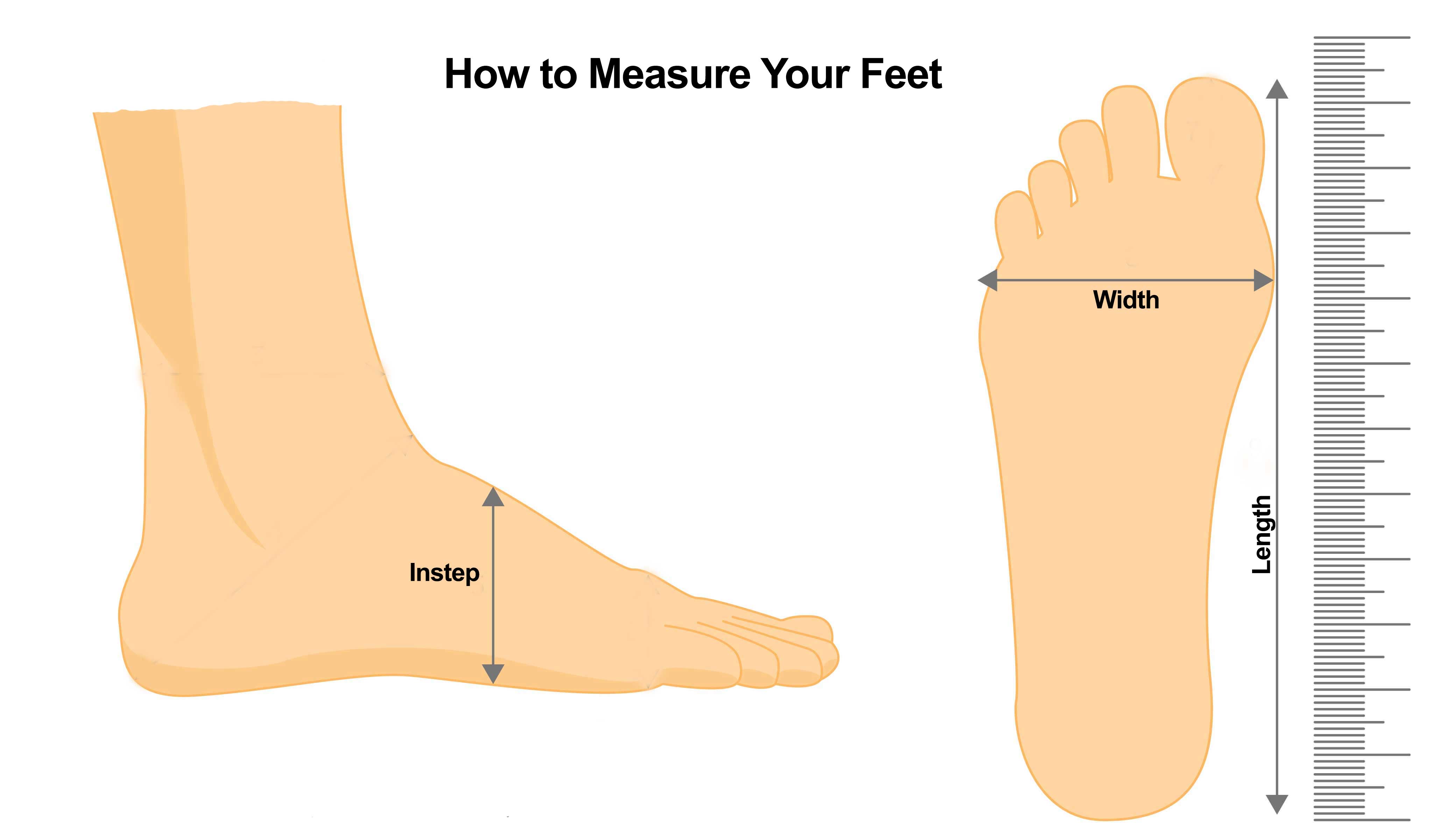Getting the Perfect Fit - Length, Width & Instep
You've likely experienced trying on several pairs of shoes in the same size, only to find they all fit differently. One of the most overlooked aspects of shoe sizing is the width and depth (volume) of the shoe. While manufacturers attempt to standardize sizes, variations in shoe construction can lead to significant differences in fit, both across different brands and even within the same brand.
Accurately measuring your feet is the essential first step toward finding the right fit. However, due to these construction variations, even a correct measurement doesn't guarantee a perfect fit across all styles. Your measurements provide a solid starting point, but you may still need to try different styles to find the one that feels just right.
Other Considerations
When trying to determine the right shoe based upon the measurements there are other factors to consider:
- What foot issues does the shoe need to accommodate; bunions, hammertoes, swelling, lymphedema, etc.?
- Do you have custom insoles or AFO (ankle foot orthotic / drop foot brace) that needs to fit inside the shoes?
- Any other foot issues; surgery or accident resulting in foot issues like a fused ankle?
- What type of shoe(s) are you looking for; Athletic, Casual, Dress, Boot, Work, Safety Toe, Heels?
- What are you currently wearing? Any shoe details for fitting reference like the Brand; shoe size, width, closure (lace, straps, slip-on), and type (athletic, casual, boot)
Standard Widths of Shoes
| Men's Widths |
|
Women's Widths |
| Narrow (B) |
|
Narrow (A) |
| Medium (D) |
|
Medium (B) |
| Wide (2E or 3E) |
|
Wide (D) |
| X-Wide (4E or 5E) |
|
X-Wide (2E or 3E) |
| XX-Wide (6E) |
|
XX-Wide (4E or 5E) |
| XXX-Wide (9E, 10E, 14E) |
|
XXX-Wide (7E, 10E, 14E) |
How to Measure Your Foot Length, Width & Instep (Volume)
To get an accurate measurement, the ICS Shoe Size Converter (below) allow you to measure your feet by using
Inches, Fractions or Centimeters.
Things you will need
- Chair
- Pencil or thin Pen
- Paper long enough to trace your foot onto. You may need to tape 2 pieces together, lengthwise
- Put on the socks you typically wear
- If you need to accommodate for an AFO (ankle foot brace), make sure to wear it for the measurements
- Tape Measure or String to measure your Instep
- Ruler or Tape Measure to measure the tracing of your feet
Follow these Steps
- Sit on the chair with your knees at a 90-degree angle, leaning forward.
- Measure foot length and foot width by tracing an outline of each foot. Keeping the pencil or pen in a straight upright position will provide an accurate measurement.
- Measure foot instep by placing the beginning of the tape measure or string on the inside arch of the foot. Drape the string over the midfoot to the other side of the floor, providing a measurement of the highest part of the arch or midfoot. Instep measurement is the space or volume needed inside the shoe.
 Determine the Inches, Fractions or Centimeters of your foot tracing
Determine the Inches, Fractions or Centimeters of your foot tracing
- Length: Using the tape measure or ruler, measure your tracing from Heel to Longest Toe.
- Right Foot __________
Left Foot __________
- Width: Using the tape measure or ruler, measure the tracing from the across the Widest part of your Foot below your Toes.
- Right Foot __________
Left Foot __________
- Instep (Volume): If you used a Tape Measure to drape over the foot, use that measurement. If a string was used, then measure the length of the string.
- Right Foot __________
Left Foot __________
Enter Your LARGEST Length, Width, and Instep below:
Shoe Size Converter
Enter your foot length:
Enter your foot width:
Enter your instep measurement:
To find the Best Shoes for your Shoe Measurements
Factors that Affect "The Fit"
There are several other factors that affect how a shoe actually fits on your foot. These include the; (1) Platform or Footbed, (2) Design & Structure of the Toe Box, (3) Upper Material type (leather, lycra, mesh, or knit), (4) Volume (space inside the shoe), and (5) Sole of the shoe. All of these factors can result in a very different fit for the same size and width shoe.
The best way to tell if you have the correct fit is - How the shoe feels when you put it on. It should feel comfortable in the Width, Length, and provide ample Volume (Space inside the shoe). Most shoes should be comfortable right out of the box. The edges of your foot should meet and align flush with the edges of the footbed. The heel should sit snugly in the heel cup (not slip) and the general feel without lacing up should be comfortable without being restrictive.
All of the factors above should be considered when selecting a shoe. The more you understand the dimensions and condition of your feet, the easier it will be to find what shoe works best for you.
ICS offers Free Consultations with our Personal Fitting Specialists. The ICS Specialists have helped hundreds of people find the Perfect Fitting Shoes for their needs. They have in-depth knowledge of foot conditions and will provide recommendations of the best shoes for your needs and lifestyle.

ICS Shoe Personal Fitting Specialists can help you find the Perfect Fitting Shoe to eliminate pain and discomfort. Taking care of your feet every day starts with the perfect fitting shoe.
Let us help you find just the right shoe for your lifestyle. Contact Your Personal Fitting Specialist Today - Your Feet Will Thank You!
(877) 553-5544 or
Contact Us by eMail.